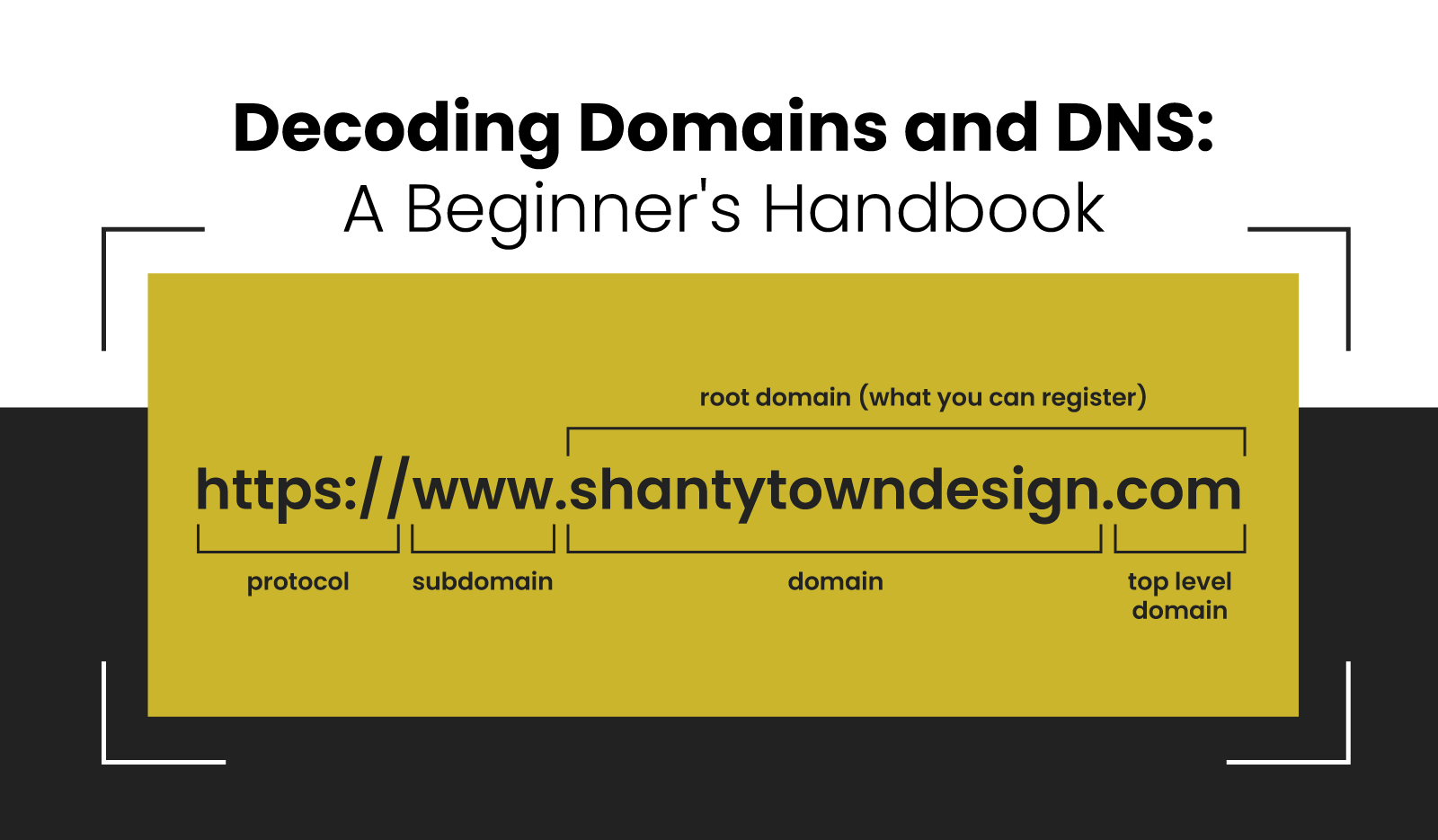Welcome to the intriguing world of domains and DNS! Imagine domains as the secret passageways that lead you to your favorite websites, and DNS as the invisible magic behind the scenes. In this beginner’s handbook, we’re here to unlock the mysteries and make it all crystal clear. So, fasten your seatbelts and get ready to embark on a journey through the fascinating realm of domains and DNS!
Domain Names
Picture a domain as the superhero alter ego of a website, donning a catchy name like CaptainAwesome.com or WonderWeb.org. It’s the unique address that people type in their browsers to reach their desired online destinations.
Just like a cool codename, a domain gives a website its identity, making it memorable and easy to find in the vast digital universe. So, whether you’re launching a blog, an e-commerce empire, or a cat video shrine, choosing the perfect domain name is like putting on a flashy cape—it’s all about making a powerful impression!
What does a domain name mean?
Now, let’s dig deeper into the gunk that makes up a domain name. Think of it as three tiers, with each tier serving a specific purpose.

All the way to the right, we have the top-level domain (TLD), which acts as the big boss of the domain world. It’s the “.com” or “.org” part you often see.
Moving down the line, we encounter the second-level domain, which is where the real magic happens. It’s the heart and soul of your website’s identity—think “Google” in “google.com.”
And if we’re feeling extra adventurous, we can venture even further by adding a subdomain. This quirky addition gives you the power to create custom sections, like “blog” in “blog.google.com.” You may recognize “www” as a common subdomain.
Picking a domain name
Picking a stellar domain name is like finding the perfect sidekick for your online adventure. Here’s why it’s essential to choose wisely:
- Memorable First Impressions: A catchy domain name grabs attention faster than a superhero swooping in. It’s your chance to make a dazzling first impression and leave a lasting mark on visitors’ minds.
- Brand Superpowers: A well-chosen domain name aligns with your brand, giving it an extra boost of recognition and recall. It’s like having a secret identity that instantly connects with your audience.
- SEO Strength: Search engines love a domain name that packs a punch. By including relevant keywords, you can soar higher in search rankings and attract more visitors to your online lair.
- User-Friendly Magic: A good domain name is easy to spell, remember, and share. It’s like a magic spell that guides visitors straight to your virtual realm, ensuring they never get lost in the digital wilderness.
- Trustworthy Aura: A professional domain name adds an aura of trust and credibility to your online presence. It signals that you’re a reliable hero in your field, ready to save the day for your customers.
- Consistent Branding: Your domain name can be the sidekick to your social media handles, email addresses, and other digital tools. Together, they form a united front, making your brand instantly recognizable and memorable.
- Future-Friendly Flexibility: A versatile domain name allows room for growth and expansion. Just like a superhero’s powers evolve over time, your domain name should be able to adapt to your future endeavors.
Remember, the right domain name is your secret weapon in the online world. So, suit up, channel your inner creativity, and choose a domain name that’s as powerful and unforgettable as your business.
Registering a Domain
It’s a thrilling quest to claim your very own domain name! Just kidding, just follow these simple steps:
- Choose Your Domain Registrar: Picture a bazaar filled with fantastic options—Namecheap, Hover, Google Domains, and more! Find the registrar that matches your style and budget, like picking the perfect stall at a vibrant market.
- Search for Your Perfect Domain: Imagine yourself as a word wizard, conjuring up the ideal domain that reflects your brand or passions. Use the registrar’s search tool to uncover hidden treasures and find the one that makes your heart skip a beat.
- Select the Right Extension: Let your creativity soar as you pick the magical extension for your domain—.com, .org, .net, or maybe something whimsical like .ninja or .pizza!
- Add to Your Cart: Time to fill your virtual cart with the domain of your dreams, just like picking out shiny trinkets from an online treasure trove. Keep an eye on the price tags, though, as some gems may be pricier than others.
- Complete the Checkout Process: It’s checkout time! Provide your contact details, select how long you want to keep your domain registered, and get ready to make it official. Pay with your trusty digital wallet or trusty credit card.
- Verify and Activate: You’re almost there! Soon, an email will arrive, bearing the secret key to activate your domain. Click that verification link or follow the enchanted instructions to unlock your online kingdom. You’re now a bona fide domain conqueror!
Now, a few tips to ensure a smooth journey:
- Compare Prices: Different registrars may offer varying prices for the same domain, so shop around to find the best deal.
- Consider Customer Support: Look for registrars with good customer support, as they can offer assistance if you encounter any challenges along the way.
- Renewal Reminders: Set reminders to renew your domain before it expires to avoid losing it. Keep an eye on those renewal dates, just like a vigilant guardian!
May your domain be as unforgettable as a catchy tune stuck in everyone’s heads!

Best Practices for Managing Domains
Congratulations, proud domain owner! Now that you’ve secured your online territory, it’s time to don your domain management cape and take charge. Here are some superheroic best practices to keep your domain safe and sound:
- Stay on Top of Renewals: Just like a loyal sidekick, set reminders for domain renewal dates. Don’t let your domain slip away into the abyss of expiration! Stay vigilant and renew in time to maintain your online kingdom.
- Fortify with Security Measures: Shield your domain from evil forces with robust security measures. Activate domain lock to prevent unauthorized transfers, enable two-factor authentication for added protection, and keep your login credentials hidden like a secret identity.
- Shield Your WHOIS Information: Maintain your privacy by opting for WHOIS protection. It’s like wearing a disguise, hiding your personal information from prying eyes and spammers. Keep your true identity a secret!
- Keep Contact Details Updated: Be a responsible domain owner and keep your contact information current. Just like a superhero with a changing phone number, update your details to ensure smooth communication with your registrar and other relevant parties.
- Backup Your Website: Superheroes always have a backup plan! Regularly backup your website and associated data to prevent losing it in case of unforeseen events. It’s like having a secret lair hidden away for emergencies, then you can always come back to it if you need to.
- Regularly Check for Suspicious Activity: Use your superhero senses to detect any signs of unusual activity. Monitor your domain for unexpected changes, unauthorized DNS modifications, or suspicious email communications. Stay one step ahead of potential threats!
- Choose a Reputable Registrar: Stick with a trusted domain registrar, known for their reliability and good reputation. Do your research and read reviews to find a registrar that aligns with your needs and provides excellent customer support.
By following these best practices, you’ll be a domain management superhero, protecting your online territory with strength and grace. So, go forth, safeguard your domain like a valiant guardian, and let your online presence shine brighter than a supernova!
The Domain Name System (DNS)
Enter DNS, the mighty translator of the web! Imagine it as a language master, fluent in the art of converting domain names into the secret codes known as IP addresses. So, while you’re busy exploring the web, DNS is working tirelessly, whispering to servers and unraveling the mysteries of connectivity.
When you type a domain name like “superawesome.com,” DNS steps in and starts its spellbinding performance.
First, it sends out a search party called a DNS resolver, a fearless explorer that embarks on a quest to find the IP address associated with the domain name. This resolver consults with other servers along the way, passing messages like secret scrolls until it discovers the right IP address. Once the IP address is found, DNS delivers it back to your device, like a magical teleportation spell, allowing you to effortlessly reach your desired website. It’s like a symphony of technology, with DNS as the conductor, orchestrating the harmonious flow of information across the digital realm.
DNS Servers
DNS servers are the guardians of the internet, each with its own superpower to keep the web spinning smoothly. They come in different flavors, so let’s meet the main ones:
- Recursive DNS Servers: These mighty servers are like the detectives of the web, tirelessly searching for answers. When you type a domain name into your browser, recursive DNS servers embark on a quest to find the IP address for you. They dig deep, consulting other DNS servers and gathering the necessary information to complete their mission.
- Authoritative DNS Servers: These servers are the masterminds behind the scenes, holding the keys to specific domains. When a recursive DNS server seeks answers, it turns to the authoritative DNS server responsible for the domain in question. These servers are the ultimate source of truth, providing the requested IP address and other important domain-related information.
Together, these servers form an intricate network, passing messages and collaborating to ensure your web journeys are seamless.
DNS Records and Their Types
Next up, DNS records! Imagine them as information tags attached to a domain name. They serve different purposes and tell the internet how to handle specific aspects of your online presence. Here are some commonly used DNS record types and their significance:
- A Record: This record is like a GPS coordinate for your website. It connects your domain name to an IP address, telling the internet where to find your website.
- CNAME Record: Think of this record as a nickname or an alias for your domain. It points your domain to another domain, allowing you to redirect traffic or set up subdomains.
- MX Record: This record is all about managing your email. It specifies the mail server responsible for handling your domain’s incoming emails. It ensures that messages reach the right inbox.
- TXT Record: This record is like a secret message attached to your domain. It allows you to add custom text information, such as SPF (Sender Policy Framework) records for email authentication or verification tokens for domain ownership.
Each record type has its role in shaping your online presence. Use an A record to connect your domain to a website, a CNAME record for redirects or subdomains, an MX record to handle email, and a TXT record for additional information. The specific use cases depend on your needs, such as setting up a website, managing email services, or verifying domain ownership for various online platforms.
Troubleshooting DNS Issues
Oh no, looks like we’ve stumbled upon some pesky DNS troubles! But don’t worry, even superheroes face challenges sometimes. Here are some common problems and tips to save the day:
- Disappearing Websites: If your website vanishes into thin air, it could be due to incorrect DNS settings or expired domain registration. Double-check that your DNS records are up to date, and make sure your domain registration is active and not expired.
- Email Woes: Are your emails playing hide-and-seek? It might be a DNS issue. Check your MX records to ensure they’re correctly pointing to the right mail server. Also, verify that your email service provider’s settings are properly configured.
- Slow Loading Times: Is your website taking ages to load, like a sloth on a coffee break? Slow DNS resolution could be the culprit. Optimize your DNS settings and consider using a reliable DNS provider to speed things up.
- Mysterious Redirections: Are your visitors being whisked away to strange places they didn’t intend to visit? Misconfigured CNAME records might be to blame. Review your CNAME settings to ensure they’re pointing to the correct destinations.
When it comes to troubleshooting DNS issues, don’t fear – there are tools and tricks to help you out:
- Check DNS Settings: Review your DNS records and ensure they’re correctly configured. Also, verify that your A, CNAME, MX, and TXT records are pointing where they should.
- Online Tools: Take advantage of nifty online tools like DNS lookup or DNS propagation checkers. They can provide insights into DNS configurations and identify potential issues.
- Seek Professional Assistance: If the DNS maze seems too daunting, don’t hesitate to call in reinforcements. Reach out to your domain registrar, web host, or IT experts for specialized help. They have the superpowers to tackle complex DNS challenges.
Remember, tackling DNS issues requires a blend of patience, detective work, and sometimes a bit of expert help. With your persistence and a sprinkle of tech know-how, you’ll conquer those DNS obstacles and restore harmony to your online universe!
Conclusion
As we reach the end of our adventure through the realms of domains and DNS, we hope you’ve gained a solid understanding of these fascinating concepts. Remember, domains and DNS are the pillars that support the interconnected web we all rely on. From unraveling the structure of domain names to exploring the magical workings of DNS servers, you now possess the knowledge to navigate this digital landscape with confidence. Remember, the world of domains and DNS is ever-evolving, so continue to explore, learn, and adapt to the exciting changes that lie ahead.
Safe travels, intrepid explorer of the digital realm!










